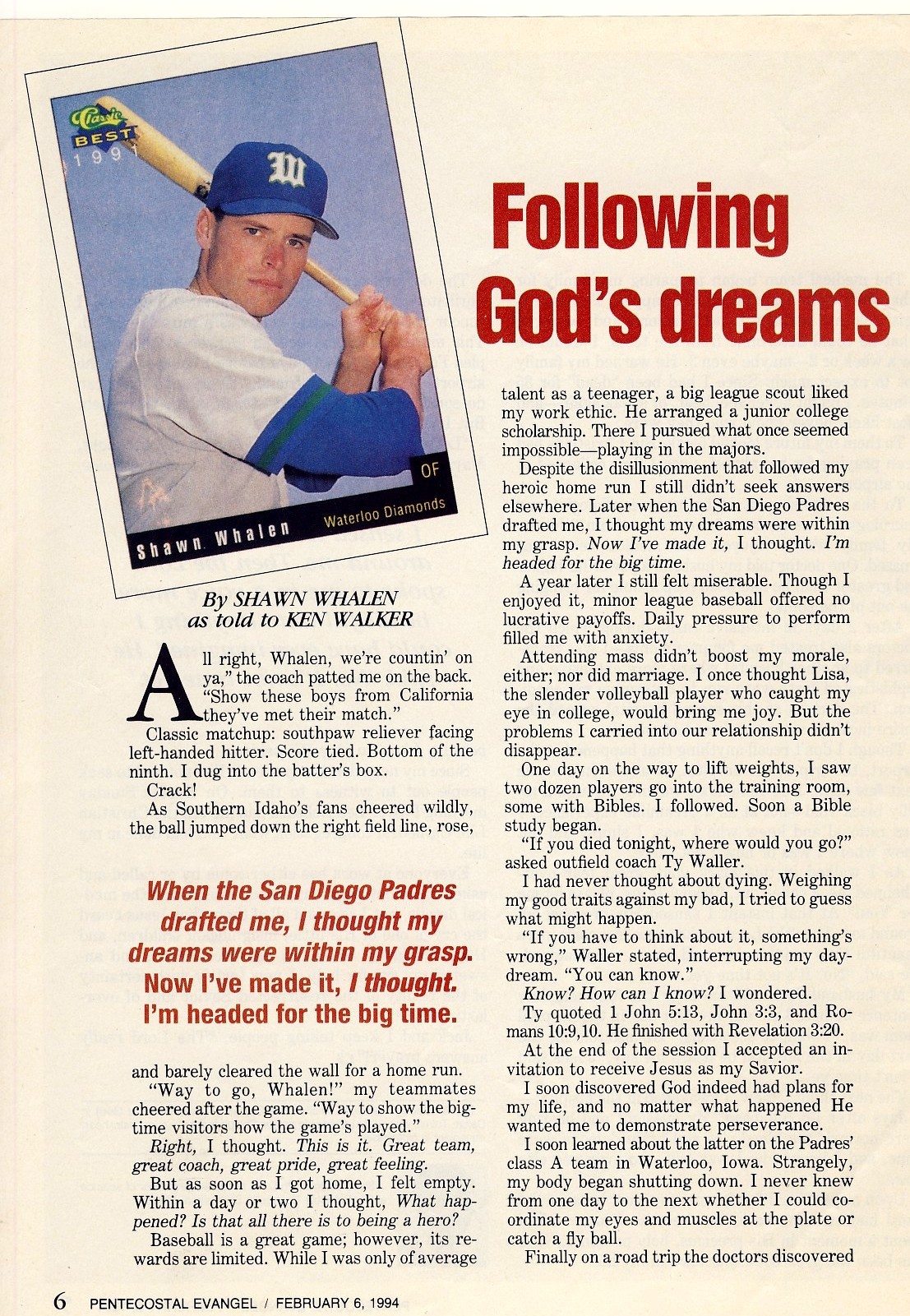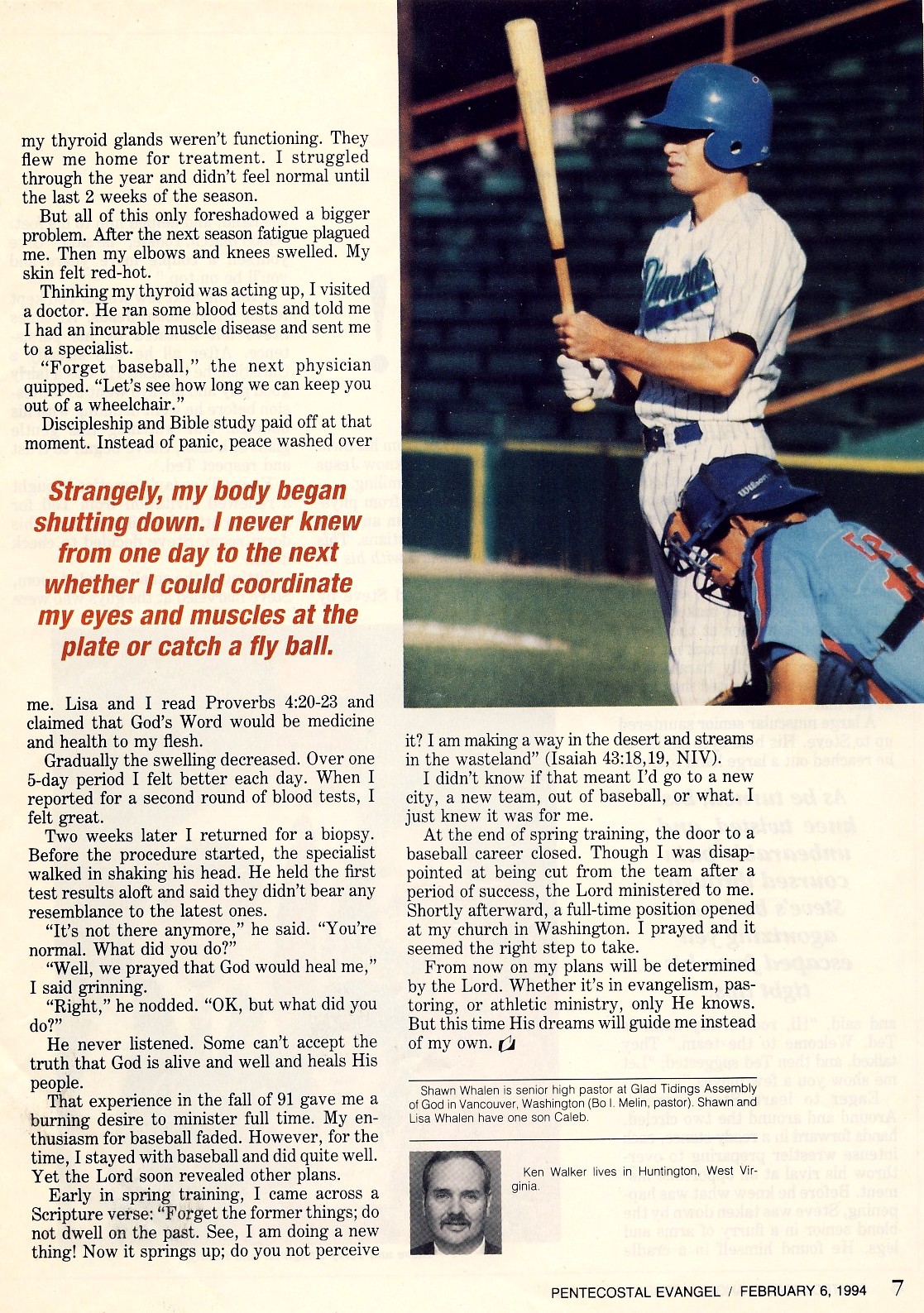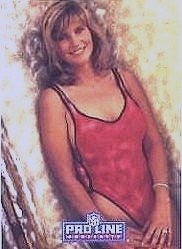
Pro Line featured the wives of some of it's sports stars
This is Ann Stark

Pro Line featured the wives of some of it's sports stars
This is Ann Stark


Pro Line featured the wives of some of it's sports stars
This is Ann Stark
TABLE OF CONTENTS
8. Purchase Your Sports Cards
9. Your Favorite Players
10. The Rookie Cards
11. Hot Cards or Hot Players
12. Rising Stars and Commons
IV. How To Organize Your Collection
13. Card boxesB. Separating Your Sports Cards
14. A school binder
15. Plastic boxes
16. A plastic sleeve
17. Separate Your Cards By The Manufacturer
18. Separate Your Cards By The Kind They Are
19. Separate Your Cards According To Your Favorite Team
20. Separate Your Cards According To Your Own Personal Preference
21. Separate Sports Cards By Sets
22. The Base Set
23. The Subset
24. Parallel card Sets
25. Insert Cards
26. Short Print Cards
27. The Traded Set
28. Memorabilia cards
29. The Team Set
30. Additional Sets to Separate
VI. How Much Money Are Your Sports Card Worth?
VII. Let's Take A Closer Look At Your Cards
VIII. A Brief History of Sports Cards
IX. Buying Sports Cards For Your Hobby
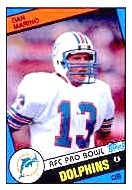
As an adult I used to collect sports cards as a hobby. Some do it for
profit
but I never did. I mainly collected sports cards.
I had some hockey, baseball, basketball, and racing cards.
I never
collected many non sports cards. Even though these are labeled as
trading cards, they are considered by most collectors to be in a
different category and should never be confused with
sports cards.
When I was a kid growing up after World War Two I used to take a sports
card or a card from a deck of cards, then take a clothes pin, and
then pin the card to the back of the frame on my bicycle. The card
would poke thru my bicycle spokes. That way my bicycle sounded like a
motorcycle when I coasted down a local hill close to where I lived.
I influenced the other neighborhood kids to do the same. Pretty
soon the whole neighborhood sounded like it had a pack of motorcycles
roaring through it. That was just one way kids found to have
clean decent fun in those days.
I also had a Daisy pump BB gun. If you took a sports card and hung it
on your mother's clothesline with a clothes pin it made a pretty good
target from 25 feet away.
It was great to Scotch tape a sports card of your favorite player to
your bedroom mirror or to thumb tack a sports card to your bedroom
wall. It was good to keep your dog and your little brother out of
your sports cards in those days because they would chew and/or
slobber on them.
It was always fun to paper clip or staple a sports card to a school paper
on sports that you were turning in for extra credit.
A sports card came in a flat package of gum in those days. You wanted
the gum and the card was just an added treat to get along with it.
It was common to take a big wad of ABC (already been chewed) gum and
stick it to the back of a sports card of a player you didn't like and
then stick it on a nearby telephone pole or highway sign. It was a
curiosity just to see how long it would stay there.
It was fun to take your steel pointed darts and back up to the far
side of the room. A sports card would be mounted on your round
dart board on the opposite wall. Then you let those darts fly one at
a time. If you hit the
card on the board you were considered a good darts player.
Well, needless to say that a lot of sports cards were ruined in those
days. Cards that would be worth some money today if kids had protected
them and safely stored them.
I briefly cover here some of my experiences and problems that I had
while collecting my sports cards as an adult.
Whether you are having a simple problem with your sports card collection
or whether you just want some simple information concerning it-
then you may find your answer here.
For some folks there is nothing more satisfying than having a hobby of
collecting sports cards.
This is a rewarding hobby enjoyed by millions of wonderful folks.
These cards can be representative of your
favorite team and/or player(s), they can make you feel important
(especially if have more or better cards than your rival), and you
can know that some of them are a good financial investment (especially
if you have the rookie card of a hot player or two). Also it is a
delight to have a hobby that you love and one that is fun.
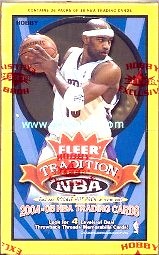

When my youngest son was about ten years old or so I was running my ministry and also driving an 18 wheeler truck so I was gone from home a lot. I was nearly a workaholic but I had a lot of things that I had to do. But I believed in taking some time for my family and one day my wife talked to me about taking more time to spend with my young son. But the problem was that I did not know how to relate to him at that age. My wife suggested that I go down to his level because he could not come up to my level. I agreed. I asked him what he and I could do together to spend some quality time together. He was instant in replying that we had to collect sports cards together. I told him that I did not know how to do that but he responded that he would teach me. So that started an every Saturday morning get together with him that would last over a several year period of time.
It was great for him getting quality daddy time and it was great for me to have not only a relationship with him but to also have a new hobby. Every Saturday morning I would take him to breakfast and then we would go to garage sales in the area (who were selling sports cards), go to a card show, or go to a card shop. We had a lot of fun and it was rewarding in more ways than one...
If you are an adult and want to relate more to your youngster then you might consider collecting sports cards together. Let it be his or her idea. I think that you will find it rewarding, as well. And sports cards make a great gift for your youngster's birthday- especially when you take him or her down to the sports store to pick the expensive ones.
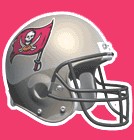
2.Cards Are Representative Of Your Favorite Team
The first thing that my son said to me was that I had to pick a football team to be my favorite one but I said to him that I did not have one. He showed me a book that had each logo of each football team in it. I had to pick one then and there. But he told me that I could not choose the Raiders because that was his team. I found a cool logo of a pirate who had a knife in his mouth. My son said that that was the logo of a team called the Tampa Bay Buccaneers and that those cards were cheap because that was a sucky team at the time. I liked that idea because it would spare me a lot of money when my son informed me that we had to purchase every card of that team that existed. So that is how I became a Buccaneer's fan even though I live in California. Later, the team changed it's logo. It's colors now are the color of cold steel and hot red blood.
In time I got real familiar with a lot of Buc's players from their cards. Of course, then, since I was an official Bucs fan I got Bucs coffee cups, ball caps, beach towels, etc. with the Bucs logo on it from my family members- all of which I proudly used. When I walked into a card exposition with my Bucs hat on each dealer there knew just what card he had that he wanted to sell me...
3.Cards Are Representative Of Your Favorite Player(s)
It is fun collecting the cards of your favorite player(s). There are many different brands of cards and you should be able to find him or her in each of them.
For instance I like Dave Dravecky from baseball and Dennis Byrd from football. There is a movie about Dennis titled "Rise and Walk- the Dennis Byrd Story". It's a good movie and I highly recommend that you watch it if you get the chance.
Dave Dravecky has several books out. His first book was titled "Comeback". This was written after the first stage of the trial of his faith. Then he went back to baseball, and soon afterwards, he entered the second stage of the trial of his faith. He then wrote at least two more books titled: "Dave Dravecky" (an autobiography), and also "The Worth Of A Man." These are great books to read and I recommend that you read them as soon as you can if you are going through a trial of your own faith. Jan Dravecky, Dave's wife, also wrote a book titled: "A Joy I'd Never Known."
4.Cards Can Make You Feel Important
(especially if have more or better cards than your rival)
Competition is healthy as long as it is done with a right motive. Competing with your friend(s) can be fun and help you enrich your collection. When I tell others that at one time I had 50,000 football cards in my garage they usually gasp with amazement. Some smile at me and tell me that they had more than that!
5. The Beckett-
This monthly magazine lists the current value of each of your sports
cards. It covers baseball, football, basketball, auto racing, and
hockey. You can usually purchase it from your local sports card
shop or purchase it online.
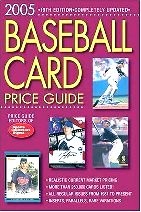 When you locate your specific card by manufacturer, set, and number
in the Beckett it may have an arrow next to it pointing up or down.
The arrow pointing up means that your card went up in value since the
last Beckett was printed. If this arrow remains up in issue after issue
then your common card has probably turned into a hot card worth more
money. However, if the arrow points down that is not good. That means
that your card went down in price. That may mean that one of your hot
cards has now dropped in value to being a common. If you don't see an
arrow (and this is the situation in most cases) it means that the
value of your card has not changed.
When you locate your specific card by manufacturer, set, and number
in the Beckett it may have an arrow next to it pointing up or down.
The arrow pointing up means that your card went up in value since the
last Beckett was printed. If this arrow remains up in issue after issue
then your common card has probably turned into a hot card worth more
money. However, if the arrow points down that is not good. That means
that your card went down in price. That may mean that one of your hot
cards has now dropped in value to being a common. If you don't see an
arrow (and this is the situation in most cases) it means that the
value of your card has not changed.
There will always be two value numbers listed for hot cards and rookies in the Beckett. The high number is the high dollar value for that card. The low number is the low dollar value for that card. This technically indicates the value for your card but this is not always an accurate indicator. The Beckett value runs on the assumption that you always have a perfect mint condition card. What happens if you don't? Then your card value will be lower than Beckett. The Beckett does not list collector value either. A collector may be willing to pay three times Beckett value to get a certain rare card or pay liberally some other way for what he or she wants. The Beckett does not reflect auction values, either. Cards sold at auction can sell for much more than Beckett values.
6. Some Cards Are A Good Financial Investment
(especially
if you have the rookie card of a popular hot player or more)
If you collect cards long enough you are eventually going to wind up with a valuable rookie card or more. I know one man who invests in sports cards rather than playing the stock market. To him, card collecting is a business and not a hobby. I don't really go into that aspect of it here because this web page is for beginners, but if you really know what you are doing you can do quite well with sport card investments.

If you are just starting out collecting sports cards as a hobby then you might want to consider collecting just one sport- your favorite sport. There are millions of sports cards in existence today and you don't want to bite off more than you can chew. My young son wanted to collect just football cards so that is the route we went. Through the years we collected a lot of football cards but we never collected them all. We never even got all of the ones that we wanted. But, at least, it was fun trying. It would have been too much to have tried to collect the other sports as well. Once you decide on the sport that you want to collect then try to stay focused as there are many temptations to veer off into other sports. Our main focus was football and we stored these cards in the card boxes. But if we wanted to collect a player from another sport we would usually place his cards in plastic sheets in a separate binder. That way we would not get too confused.
If you collect only one sport then you only have to purchase one Beckett for that sport once every month or once every few months. Purchasing a Beckett once a month or so can get expensive and sometimes one does not see the value of his cards go up that much in that time. If you have older cards that are not listed currently then you will have to purchase books from Beckett (or from others) that list the items that you have.
Sports cards cover several different sports- the main ones are:
baseball
football
basketball
hockey
auto racing
boxing
and golf
not necessarily in that order...
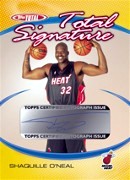
7. Sport Card Manufacturers
Here is a brief list of who they are and what they make:
Topps
Topps produced it's first sports cards in 1939.
Topps produces cards also under the name of Bowman, and Stadium Club.
A few examples of the cards Topps produces is
Bowman's Best
Topps Gold Label
Topps Chrome
Upper Deck
Upper Deck produced it's first sports cards in 1989. It was the 5th
license to be granted for the manufacture of sports cards.
Upper Deck produces cards also under the name of Collector's Choice,
and Black Diamond.
A few examples of the cards Upper Deck produces is
Classic Portraits
Encore
Victory
SPX
Donruss
Donruss is based in Texas and produced it's first sports cards in 1981.
Donruss produces cards also under the name of Playoff, Pacific,
Leaf, Score, and Pinnacle.
A few examples of the cards Donruss produces is
Elite
Pacific Impressions
Classics
Gridiron Kings
Fleer
Fleer produced it's first sports cards in 1959 and went out of
business. Some cards were produced in 2005. Fleer may resume
production of sports cards (under new owners or management?).
Fleer produced cards also under the name of Stars and Stripes,
Ultra, and Sky Box
A few examples of the cards Fleer produced was
Maximum
Tradition
Showcase
Action Packed
Action Packed produced it's first sports cards about 1990 or so
and went out of business. I don't believe any cards were produced
by them after 1998.
Pro Set
Pro Set produced it's first sports cards about 1990 or so and went
out out of business. I don't believe any cards were produced by
them after 1998.
One example of the cards Pro Set produced was
Pro Line
New Sport
This sport card manufacturer is in France.
Canadian Cards:
O-Pee-Chee and Donruss Leaf.
MLB
MLB is licensed to sell sport cards under the Players License
and is owned by Hasbro (Toy Company) in Washington State. It mainly
sells baseball promo cards.
A few examples of the cards MLB produces is
Showdown
Sports Clix
Be A Player (BAP)
BAP also produces cards under the name of In The Game.
In The Game has produced hockey cards since the 1998-99 season.
Others
Some sports cards have also been produced from time to time by
Collegiate, Notre Dame, Panini, Star-Cal, Swell and many
cereal companies and corporate companies. For instance, Kellogg
produced a total of 14 sets of 3D baseball cards starting in 1970.

8. Purchase Your Sports Cards
A young person will usually purchase a pack or two at a time from their local grocery store depending on how much allowance money he or she has. Comparison shopping is good here because different stores (who sell sports packs) sell them for different prices and you want to get the packs for the lowest possible price. Everyone knows that you have to work hard for your money so it is important to find the best bargain(s).
When my youngest son was ten years old I used to give him an allowance for doing household chores. The first thing that he did after he got paid was to head for the store to buy some packs of sports cards. But then we started going together on Saturday mornings. That was a different story. Then he took his allowance to the card shop or the card show and spent it there. It was important for him to have his own money and for him to learn how to handle it. Yes, he made his mistakes but that is how he learned. And I did the same thing. I guess that is why they put erasers on the end of pencils.
9.Your Favorite Players
If you have a favorite player or players then you might want to get all of the cards pertaining to each one. I like Dave Dravecky who was a baseball pitcher for the San Diego Padres and then the San Francisco Giants in 1987. While I was collecting football cards with my son I kept a look out for the Dravecky cards as well. In the course of a few years I was able to get all of his rookie cards as well as an autographed card. I read his book on the trial of his faith and the ordeal that he had to go through in getting his arm cut off. My personal hope is that many will recognize his faithfulness to the Lord during his trial. He is still one of my all time favorite players of the game.
So, if you have a favorite player (or more) in any sport you can enrich your hobby by collecting all of his or hers cards.
10.The Rookie Cards
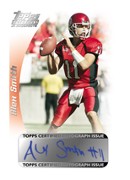 The most important cards for any player are his rookie cards.
A rookie card is the very first card made of your player
per card company just after he or she goes professional. Some cards
are made before they go pro (usually called promo cards)
but these are not considered to be the rookie cards. In the old days
a player only had one rookie card, but, at present, a player can have
several rookie cards- as many as are printed by the card companies.
These cards are his most sought after cards and usually have
the highest values. It's great to get some rookie cards of a new
player before he becomes a super star. That way you get
them at a low price and can save money or make money if you want to
sell them later on. Some folks like to collect all rookie cards of
every player in the hopes of improving their hobby's collection or in
the hopes of selling them for more money later on. But these cards are
hard to get and cost more- and not every player is going to make the
Hall of Fame. If a player makes the Hall of Fame, generally,
one of his rookie cards can then sell for a lot more money- sometimes
hundreds of dollars. If you
have any doubt as how to recognize a player's rookie cards then look
in the Beckett as they are marked there as his rookie cards.
The most important cards for any player are his rookie cards.
A rookie card is the very first card made of your player
per card company just after he or she goes professional. Some cards
are made before they go pro (usually called promo cards)
but these are not considered to be the rookie cards. In the old days
a player only had one rookie card, but, at present, a player can have
several rookie cards- as many as are printed by the card companies.
These cards are his most sought after cards and usually have
the highest values. It's great to get some rookie cards of a new
player before he becomes a super star. That way you get
them at a low price and can save money or make money if you want to
sell them later on. Some folks like to collect all rookie cards of
every player in the hopes of improving their hobby's collection or in
the hopes of selling them for more money later on. But these cards are
hard to get and cost more- and not every player is going to make the
Hall of Fame. If a player makes the Hall of Fame, generally,
one of his rookie cards can then sell for a lot more money- sometimes
hundreds of dollars. If you
have any doubt as how to recognize a player's rookie cards then look
in the Beckett as they are marked there as his rookie cards.
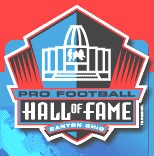
Remember, only 5 players per year are inducted into the football Hall Of Fame (HOF). Go to that website to get a list of all of those players if you come across some old cards. I bought a box of 5,000 old baseball cards at a garage sale one time for $20.00. Me and my son had fun going through all of them and sorting them out. I believe that at the time we had a list of all of the baseball Hall of Famers that we got from our local library but none of those players were in that box- they were mostly commons. If you have a rookie card of a player who made the HOF, and the card is in mint condition and not a forgery, then you can be assured that it is a highly sought after card and a collector may pay you a lot of money to get it from you.
Baseball and Basketball each have a Hall of Fame and you can check online to see if your favorite sport has one. Sometimes the Hall of Fame committee will appoint a player to the HOF who has not played the game in 20 or more years. This sends card investors into a near scramble to get his cards as that player's cards may have been out of circulation for 20 years or more. So, sometimes cards of important players that you think are of little worth now may turn out to be worth something after all if you hang onto them long enough.
A player's popularity with the public is nearly everything.
A player has to be extremely good on the field as well as popular at
the same time. As long as a player has those two things going for him
or her then the card values for that player will remain high.
This is the key for collecting the rookie cards for the right players.
A player has to be retired from active play on the field for a period
of 5 years before he or she can be a candidate for induction into
football's HOF and the same for baseball's HOF.
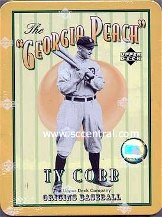
 11. Hot Cards or Hot Players
11. Hot Cards or Hot Players
Hot cards are cards of players who are pros who are popular and doing a great job. Each sport has them. Hot cards are cards other than a player's rookie cards. Generally, each of these cards is of a player who has the potential of going to the Hall of Fame someday. Each of these cards will cost more than a common but less than his or her rookie card. However, there are exceptions when it comes to rare issue cards of that player.
There is an up side to collecting these kinds of cards. It really makes a collector feel good when he buys a hot card for a low price and then watches the value of that card climb in a short time to many more times than what he or she originally paid for it.
But there is a down side to collecting some hot player cards as well. If you have a lot of hot cards from one player that you paid high dollar amounts for and then that player gets permanently hurt, down traded, cut, or quits the game then the price of each of those cards can go to minimum value real fast.
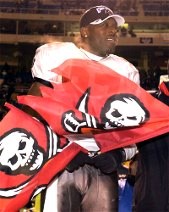 12.Rising Stars and Commons
12.Rising Stars and Commons
New or young players who are "hot" or who so far are showing a lot of promise of making a great player are labeled by many card companies as rising stars. That usually means that you are going to pay more for it. A common card is a card of a good pro player who is only average in many respects. There are hundreds of these kinds of cards and most are relatively cheap to purchase.
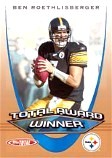
A. Physically Separating Your Sports Cards:
13. Card boxes are a great way to physically separate cards as well as to store cards. These boxes are cardboard and load from the top and keep your cards relatively safe from damage. They are not expensive and store quite well in limited spaces.
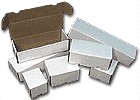
14. A school binder is another great way to physically separate
sports cards. Make sure that the plastic pages that you put inside
are especially made for cards because some plastic is harmful to
cards.

15. Plastic boxes are a great way to physically separate cards as well as to store cards for long periods of time. These boxes are plastic and keep your cards relatively safe from damage. They come in different sizes. They are not expensive and store quite well in limited spaces. They are made for cards so the plastic is card friendly.
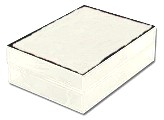
16. A plastic sleeve helps to physically separate one card as well as to protect an individual card. These sleeves are plastic and keep your cards relatively safe from damage. A sleeve should protect your card from getting scratched or from having the gloss rubbed off of it. Sleeves are quite low in price. I generally put any card over a common in a sleeve. Sleeves come in two varieties. Thin sleeves and thick sleeves. Thin sleeves are not expensive and store easily in card boxes. However, the thicker plastic sleeves are larger and generally harder to store unless you use a larger box than a trading card box.

B. Separating Your Sports Cards:
17. Separate Your Cards By The Manufacturer
You need to go through your collection and separate your cards.
One way you can separate your cards is by the manufacturer.
You can put all of your Topps cards in one card box, put all of your
Donruss cards in another card box, and all of your Fleer cards in yet
another card box. This makes the cards easier to find for set building.
You can also use plastic boxes and binders if you so choose.
18. Separate Your Cards By The Kind They Are
You can also separate them by kind. For instance, I collected all
football coach cards for awhile. I placed all my coach cards in a
separate box. I also collected all football quarterback cards for
awhile. I placed all of my quarterback cards in a separate box.
19. Separate Your Cards According To Your Favorite Team
You can also separate them according to your favorite team. I collected
some Texas Rangers baseball cards for awhile and placed these in a
separate box- this box was well labeled so I could find it easy amidst
all of the other boxes that I had. I also collected Tampa Bay
Buccaneer football cards for awhile and placed these in separate boxes.
20. Separate Your Cards According To Your Own Personal Preference
You can also separate them according to your own personal
preference. I collected all Christian football players for awhile
and placed these cards in a separate binder. For instance, I collected
Dennis Byrd
football cards. He played defense for the New York Jets until he broke
his neck during the game. His cards were never expensive but I was glad
to collect them because of who Dennis was and because of Who he
represented.
Some collectors like to collect players who have the same birthday as theirs, or players who have gotten in trouble with the law, or players who begin their last name with a certain letter, or players who have a certain jersey number, or players who have the same first name as theirs, etc. It does not really matter how you do it as long as you have fun doing what you are doing.
You can also collect and separate your cards according to the following:
21. Separate Sports Cards By Sets:

22. The Base Set-
The price of a base set is usually listed in
the Beckett. Sometimes you can purchase a base set directly from the
card manufacturer but that does not guarantee you that each card in
that boxed set is going to be in perfect mint condition. Some cards
may be off centered or cut crooked and these will devalue your base
set when you go to trade it or sell it. That is why most serious card
collector's purchase individual cards in mint condition to build their
sets with.
The base set usually comes out early in the season before the rookies
are drafted in that sport.
Then they usually come out with a set of
rookie cards of players who have been drafted. This is an expensive
set to purchase. Also some card manufacturers have all the rookie
cards numbered in order at the beginning of the base set. For example, maybe
the first 33 cards will be rookie cards of the new draft picks.
Then they come out with
whatever else they want to which can be wide and varied in scope,
intensity, and price.
24. Parallel Card Sets-
Separate your Leaf cards from the rest of your Donus collection. Leaf
is a parallel card set.
If you have Leaf cards- these Canadian Donrus cards are nearly identical to
American Donrus cards of the same year except they are considered to
be individual sets
in their own right. In other words you can't place Leaf cards in your
(American made) Donrus card collection to help you complete an American
base set even though Leaf is also made by Donrus and the cards may have
identical numbers.
Each card manufacturer decides how many cards it is going to print
in order to make a complete set. This is called the base set.
Each card has a number. Most base sets go from number 1 to
approximately 600 in order.
That means that you have to collect all 600 cards in order to make a
complete base set. Sometimes the base set is fewer than 600 or more
than 600 cards. Most often the base set will contain hot rookie cards,
other hot player cards, and/or certain cards that are short printed.
That means that you are going to have to pay whatever it takes to
complete your base set.
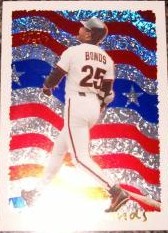 23. The Subset-
23. The Subset-
These are cards that are included in the base set that are special.
Many are only Rookie cards.
They are marked in a special way and comprise a set of their own.
You can say that it is a set within a set. In baseball Donruss produces
Diamond Kings while and Topps produces League Leader, etc. You can
buy subset cards in regular packs but they are more rare.
Card companies can produce more than one base set if they want to.
These two sets are the same, yet different. They usually
have their own values listed in the Becket. Just when you thought you had all of the cards of your
players collected then you come across the parallel ones that you also
have to have. My recommendation: take extra cash with you if you go to
the card expositions. It's no telling what you may find there.
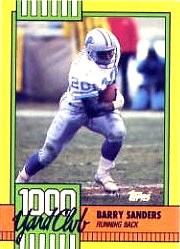
25. Insert Cards-
Each of these kinds of cards is unique in design.
An example might be-
(for football) all cards might be marked as "1,000 yard club" at
the bottom
of each of the respective cards. Or they may be marked as MVP (most valuable
player) or marked with another label of some kind. Sport card manufacturers have a right to use unique designs
or artwork, use unique wording, use unique lettering or numbering as
they see fit. To them it increases not only corporate uniqueness,
desirability, and marketing, but decreases the possibility of
counterfeiting.
Insert cards are not to be confused with subset cards.
Generally, insert cards are not numbered in order the way that each
subset is numbered, however, each card manufacturer has a right to
change this at will, so check your Beckett if you need to.
All insert cards don't have to be rectangular. Some cards have
rounded unevenly cut tops. Some are refractors that have a glossy metallic
surface. Some are die cuts where the surface of the
original has been layered and it looks three dimensional. Some are
holoview cards that give depth to the photo of the player. These are
but a few examples of what the card manufacturers have created.
Playoff created the Hogg Heaven cards since a football is called a
pig skin. A pig is a hog so to speak. Each of these Hogg of Fame,
Hogg Wild, or Material Hoggs
cards contain a piece of leather (a representation of the pig skin
football). The card companies have something
for everyone it seems.
Generally, card manufacturers do not sell insert cards individually
from the factory. Most manufacturers still insert these kinds of cards
into their card packs that they produce. These cards appear to be more
plentiful now per pack than they were before the turn of the century.
These cards are generally more expensive than common cards.
27. The Traded Set-
28. Memorabilia cards-
29. The Team Set-
30. Additional Sets to Separate-
Then there are some unusual commemorative card sets that do not come
out every year.
The Topps Heritage set has recent cards that look like some
of it's older cards of many years ago. It has players who were
famous many years ago. And Fleer did the same with it's
Greats of the Game set.
Sometimes a card manufacturer may reprint an
entire set of previously printed cards as well.
So, there are lots of sports cards to collect but I recommend that
you collect only one sport and then separate your cards in a way that
is easy and safe for you to manage. Being organized will help you to
have fun with your hobby.
Insert cards are cards that are not printed as much as other cards.
Before the turn of the century maybe only four packs out of every 100
packs that you bought had one of these cards.
That meant that not everyone got one. Somebody had to do without.
Those few cards were randomly inserted into packs. But the card
manufacturers have changed their strategy for today's market.
Now, each card manufacturer has it's own unique
strategy for how it handles it's insert cards. This info is usually
posted on each card manufacturer's website. If you can't find it then
try reading their FAQ page or email the company with your question.
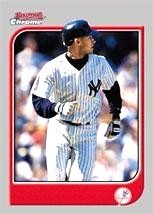 26. Short Print Cards-
26. Short Print Cards-
Short print cards are unique subset cards, mainly rookie players.
However they
can be of hot players as well. Short print cards are not numerous
and in that respect they are the same as insert cards. However, they
differ from insert cards mainly by numbering. If a card
manufacturer designates many of these as part of a base set then they
are numbered in order, one after another. The letters SP stand for
short print- you will see SP next to a player's card in the Beckett.
If you see SP and cannot think of the words short print then you
might think of SP as standing for the word special- for
that's what each of those cards is.
A traded set is a separate set of cards made by the card manufacturer
usually once a year that features players who switched teams during
the season, as well as those late comers (players hired off of the
street or players rehired after a short retirement) etc.
Topps appears to have started traded sets in 1981. Other companies also
produce traded sets, although they are called different names such
as Fleer Update and the Score Rookie Traded Set.
A memorabilia card is a rare type of insert card that may be
autographed by the player or contain some piece of equipment used by
the player in a pro game or pro auto race. Some card may have
inserted in it a splinter piece
of a baseball bat, a small piece of a football jersey, a part of his
racing car, or whatever.
This kind of card is more rare than a player's rookie cards, and
will often bring a high price to you from the right collector.
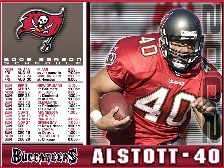
Each team in your favorite sport usually has a team set of cards.
Some team sets have a team roster card or team checklist card listing
all of the players and the card numbers. For instance, I collected
many Buccaneers team sets since the time they became an expansion
team.
Besides the above mentioned sports cards most card manufacturers
also make at least one premium set every year. However, they can
make much more if they want to. Some of these names are Fleer Ultra,
Topps Stadium Club, Upper Deck Collectors Choice, Upper Deck SPX,
and Topps Gold Label, to mention just a few. These cards cost more
but usually have cool
photos of some of your favorite players.

Today, one has to take precision care of each card if he or she wants that card to be marketable. That means that you can't place your cards on your breakfast table that still has syrup on it. That means that you should not just throw all of your sports cards in one big oil soaked cardboard box that was once used for motor oil. You can still have fun with your cards but just be mindful to handle each one with care.
31. Storing Your Cards-
Let's say that there are 9,000 total baseball cards
printed by a total of all the card manufacturers in one year. Let's say that
you collect them all. What are you going to do with them? It's a
good chance that you are going to have to store them at least for a
short period of time. In this case it's not just enough to be
organized but prepared over the long haul.
Even if you sell off your rookies and hot players you are going to be left with thousands of cards left over. And you don't want to throw them away because, after all, they are worth something. Many collectors store them. However, some individuals donate thousands of their commons to a local church youth organization or local boys or girls club in exchange for a tax receipt. This is a win-win situation for nearly everyone. And a lot of those kids have fun with the cards you no longer want.
You may have two major goals in storing your cards. One goal is to protect your cards from getting damaged. This is good for long or short duration. The other goal is to keep your cards handy in order to be able to get to them frequently in order to change or catalog them.
For long term storage over several years it is best to use a clear plastic rectangular card box. Some of these hold 250 cards each. The cards lay down flat inside of this box. These kinds of plastic boxes protect the cards against insects and dirt. You may have 10 or 20 of these plastic boxes that you plan on placing on a self in your garage. That is good, however, smaller plastic card boxes are handled differently. These store 10, 25, 50, or 75 cards each. Smaller plastic containers like these need to be placed in storage on end rather than flat. This method keeps the cards inside from getting packed together and then fused together over time (especially if some weight is on top of them).
I don't recommend using a school binder to store your cards in for a long period of time. A spider or cock roach might want to live in the center of a dormant binder on the shelf in your garage or barn. That's not a good scenario.
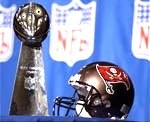
32. Displaying Your Cards-
When you go to a card show observe how the dealers there display their cards for sale. Some use a school binder that has cards inside of it. Some use sleeves- some thin sleeves and/or some thick sleeves. Some use a screw type plastic holder for valuable cards. Some of these pieces of plastic are quite thick and screwed together with one or more metal screws.
33. Toxic Plastic Is Not For Cards-
Manufacturers of general plastics include plasticizers (chemical softening agents) and stearates in their products. Some products contain plasticized PVC. Some plastic products contain acid. All or part of this poses a threat to sports cards.
Most card Sleeves are acid free and use crystal clear polypropylene. Some acrylic holders contain UV absorbers to help protect your collection against ultraviolet yellowing.
Basically, if you buy plastic items from a card store or a card dealer somewhere then you are going to be in good shape in regards to the right kind of plastic to use for cards.
34. Trading Your Cards-
It's common for youngsters to trade what they don't want for what they
want. That's true for sports cards as well. My young son traded off all
of his basketball cards for football cards with one of his friends.
His friend was the same way. He wanted basketball cards and did not
want any football cards. Neither one of them payed any attention
to Beckett value, rookie cards, or cards of hot players. That's the
simplest way to do it.
Then my son traded some of his other sports cards for a valuable baseball card supposedly worth a lot of money. We telephoned a local card shop one Saturday morning and the owner was greatly interested in looking at it so we brought it in to him to evaluate. He looked at it under a magnifying glass real carefully. It had a bad crease right through the middle of it. The corners were rounded badly and it was off centered. The owner shook his head and said that it was in bad condition- it had no value. It was worthless. So, later my son traded it off to some other kid who wanted it for some other cards. So, that's how trading sports cards goes- with kids and also with adults...

To find the monetary value for each of your cards you need a price guide of some sort. The most popular guide is produced by Beckett. The annual Beckett Football Card Price Guide is a good source for prices of cards. It goes back a couple of years. Beckett has a monthly price guide if you don't want the annual one. You might consider trading some of your extra cards to a friend for his latest Beckett or a recently outdated one that he or she doesn't want anymore. If you don't want a Beckett, you can purchase online price guides or other publications that will give you the money info amounts for your cards.
The rarety of a card strongly determines it's value. If you have a card that is a short print then it is going to be worth more than a common card. Short prints are only printed in a limited quantity- meaning that there are only so many made. Generally, the fewer the cards the higher the price. Conversely, the more the cards the less the price. The hard fact is that since 1990 or so there have been thousands of copies of each card made so there are few if any rareties from that time to this time. That means a lower price for you in this regard.
Collecting cards from a card company that has gone out of business, reasoning that it's cards are going to be valuable some day because that manufacturer isn't around any more, may be true in a hundred years or more. That's because so many were made by that company when it was in business.
The quality of a card also strongly determines it's value. The quality is determined by it's grade. I mention more about grading a little later on. Simply put, if a card is in mint condition then it's value will be the highest.
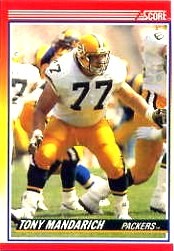
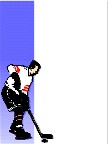
35. Grading Your Cards-
There are certain professional persons in the sports card field.
Many work for professional card grading
companies. If you want to
know who these companies are you can find out online- just type in
sport card grading companies in the subject title of your favorite
search engine. You should get a whole list of them and then you can
take your pick of the ones that you prefer.
When a professional evaluates your card he or she usually grades it. It is kind of like when a school teacher grades your school work.
Just as each school teacher has a different way of grading one of your
school papers, so each grading company has the right to grade one of
your cards any way it wants to. Usually, each website of each of the
card grading companies contains the info on how that company grades.
Here are some examples: PSA 1-10, BCG 1-10 with half-grades (.5),
SGC 1-100, etc.
Sometimes you can find graded cards available for sale at card shows
and sports card shops. Sometimes a dealer may use the top ten method.
In this case the grade is something like this:
Centering 8.5, Surface 10, Corners 9.5, Edges 9,
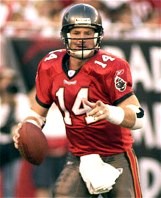 36. Expensive Cards Must Be Graded-
36. Expensive Cards Must Be Graded-
Getting one of your expensive cards graded is mandantory and not an
option if you plan on selling it for a lot of money. Somebody has to
take a closer look at your card and give it a grade. It is a rare
collector who spends a lot of money on purchasing an ungraded card.
After all, one never knows when it may be a forgery.
Most sports card dealers accept the results from the professional sports card grading companies.
If you take your valuable card to your local sports shop for a quick sell without getting it graded, the dealer will personally examine it before he or she decides to buy it from you. The dealer evaluates it because he or she is planning on re-selling it quickly for a profit. All of this can be done without having it graded. Since you don't have it graded and since you are just selling it locally to make some quick money, then you are only going to get a small amount of money for it- probably less than half the Beckett value. But, that's how this business works.
Sometimes you can find a dealer (online) who will look at your ungraded card if you mail it to him. He will then evaluate it himself before buying your card from you and only pay you what he thinks it is worth to him.
37. Grading Companies Look For Flaws:
The grader wants to see a valuable card from you that is totally
perfect in every way. So, keep in mind the following:
The grader will mark your card down if it is off centered.
The grader will mark your card down if it is stained.
The grader will mark your card down if it is out of focus.
The grader will mark your card down if it has printing defects.
The grader will mark your card down if it has marks on it.
The grader will mark your card down if it has rounded corners.
The grader will mark your card down if it has wrinkles.
The grader will mark your card down if it has bad edges.
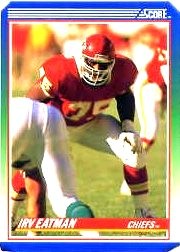
38. General Grading Guidelines:
Each grading company has it own individual standards, however,
most grade along these general guidelines:
A mint condition card.
A near mint condition card.
A card in excellent condition.
A card in very good condition.
A card in good condition.
A card in fair condition.
A card in poor condition.
39. Baseball Cards Ruled
Topps started printing sports cards in 1939 during the Great
Depression era before World War Two.
You won't find many cards made during World War Two because a lot of
paper products went in those days to the war effort instead. After
the war Bowman made baseball cards from 1948 to 1955.
It was usual for a set to only have 48 cards or so at that time. Topps resumed
making baseball cards again in 1951. They were the first company to
expand their base set to 572 cards in 1960.
Brothers Don and Russell Weiner started their Donruss
company in 1954. It was sold a couple of times over the years but
is still going strong at present in the sports card arena.
Fleer started in 1959.
Upper Deck started in 1989.
40. Baseball Cards Still Rule
More baseball cards are sold at present than of any other sport.
When lots of adults started collecting sports cards this hobby really took
off in a big way. The card
companies then started producing some premium quality cards to appeal
to adult tastes. These kinds of cards looked better, seemed to have
a higher "status" connected with them, and also costed more money. But
younger people collected them as well so they are still popular and
still manufactured.
Just before the turn of the 21st Century many card manufacturers appeared
to alter their base sets of cards. Many reduced the total number of
cards to under 550. Many reduced the number of common cards that they
made. Many included several cards each of a retired player who had already
made the Hall of Fame (because that player was popular). Many
new insert cards and special cards were created. And there have been
other important changes as well.
What kind of a card you want to buy and how much you want to pay for
it is strictly up to you. Where you want to shop for that card is
also up to you. If you are collecting very special cards then you will
probably have different shopping habits than a person who is just
collecting cards to finish some base sets. My focus here is just on the
simple hobbist who collects sport cards for the fun of it- just like
me and my son did for several years.
41. Your Local Store-
42. Your Local Sports Store-
Many times the dealer will have large
boxes of individual cards for sale on his shelves. The dealer will
usually let you browse through one large box of cards (approximately
3,000 per box) at a time. Set aside the individual cards that you want to buy.
Be careful not to damage his cards. Plan on spending a lot of time
there if you decide to shop this way. There are lots of treasures there
that you may find that you want. My son and I usually bought a large
stack of cards that way at a time. You may find cards that
you haven't seen before or didn't know existed before that time.
I had a binder full of paper pages that had my card inventory on it
that I would take to the card shops with me. This kept me from buying
a card that I already had. And my son nearly had a photographic
memory at that time and could tell me what cards that I needed from
the ones that I already had.
43. Your Local Card Shows-
Usually, this is just a big auditorium or gymnasium. Each dealer
there will set up a table or two or a display of some kind. It is common
for one dealer to go to another dealer's table to purchase some special
cards before the event opens. Generally, each person going to the card show has
to pay admission in order to get in. Sometimes individual admission
is free. Once you get there plan on spending some time there and
doing a lot of shopping. Dealers love to have you talk to them, ask prices, and answer your questions.
Sometimes you can bargain the dealer down in price and then sometimes
you can't but it is fun trying.
It is best when you first get there to visit all of the tables of all
of the dealers present. See what kind of inventory each one has and
what the prices are. Take note of any items that you might want.
But don't buy anything just yet. Just browse all of the tables.
Then shop for the best buys. One time I didn't do this and bought a card at the first table for
a sum of money. Then I found the same card at the next dealer's table for
half the price. So it pays to shop around.
44. Your Local Flea Market-
And sometimes an individual who wants to sell off
a lot of his commons will take a box of cards to the flea market and
place this for sale along with his other general merchandise. I looked
through a big cardboard box one time that must have had 4,000 or so
common cards in it for a reasonable price. I didn't buy it because I already had thousands of
common cards myself and didn't need any more.
46. Other Ways To Purchase Cards:
Then there is online purchasing. The internet has opened up this hobby-
there should be less frustration when one can find the card that he or
she needs.
Online auctions seem to be popular. My oldest son bought a lot of his
cards through auctions held on Ebay and was able to save some
money that way.
To put it bluntly- there has to be money in selling sports cards or
no one would be doing it.
47. Decide What You Want To Sell-
My oldest son came up with a good way to overcome this problem.
He collected a lot of cards. Then he would divide up one set of cards
into three groups: his firsts, his seconds, and his thirds. His thirds
meant that he had three identical cards. He would only sell or trade
off his thirds. That meant that he still had two identical cards
in reserve to do with what he wanted later on.
49. Selling Your Cards Online-
Selling your cards online is not too hard. Find a buyer, agree on
your price, and then collect the money for your card. I don't cover
here methods of payment that you can receive. But you need to have
your card graded before you sell it online, in most instances. That
means that you will have to send it to one of the grading companies.
To do that you will need to pack it carefully. I cover some packing
tips further on in this section.
50. Selling Your Cards At A Card Show-
51. Other Ways to Sell Your Cards-
52. Shipping Your Sports Cards-
One way to ship a card is to place it into a thick plastic sleeve that
is very hard to bend. Place this sleeve into a small padded envelope
and then mail it special at the post office. The sleeve and the
postage combined should not cost a whole lot of money.
B. Sandwich the now soft sleeved sports card in between 2 of the
decoy cards that sports card manufacturers are putting into packs to
prevent pack searching. These decoy cards are thicker and usually
have an ad from the company on them.
C. Place the sandwiched baseball card into a manila padded envelope.
(Important! - Be sure to write "do not bend" or "Do not bend
photographs enclosed" on the envelope, this will help remind the
series of people that handle your item to use care when handling
your piece of mail.)"
Packing the BGS Way:
Perhaps the most overlooked aspect of submitting cards for
professional grading is how they are packaged. Your cards may be Gem
Mint quality, but if shipped poorly, they can easily be damaged in
transit.
The first step is selecting the holder. BGS has received cards
wrapped in napkins, rubber banded inside a folded piece of paper,
sent raw in a plain envelope and mailed in folded nine-pocket sheets.
Screwdowns are an absolute no-no. Card corners can slide out of the
holder and bend over completely. It's no fun to get cards back
ungraded because they were submitted in screwdown holders. Any form
of snap case (team set boxes, snap-tites, mini snap-tites, etc.) is
also risky. These are easily broken or cracked during a rough ride in
the mailbag.
Top loaders are the most popular choice, but even these have their
share of problems. If the card is not in a penny sleeve, it can
rattle around and nick corners and edges. A tight top loader can
scratch the surface of sensitive cards. When the card is placed in
a penny sleeve and then inside a top loader, there is still a great
risk of the card sliding out slightly. Just because you pack them
right side up does not mean they will stay that way during the
shipping process. Taping the top of the holders solves this problem
somewhat, but it also can result in the cards sticking to the tape
itself, risking surface damage.
The safest way to package your order is a combination of penny
sleeves and oversized, (vintage) semi-rigid holders (such as the
Card Saver I). To guard against nicking a corner on a tight penny
sleeve, cut off a very small piece of one of the top corners. You
may also try to peel or slice the edge of the seal itself, about
one-fourth inch at the top right or left edge. This allows the card
to be started into the sleeve at an angle that avoids corner damage.
Once in the penny sleeve, place this in the semi-rigid holder. You
may group these together into stacks of 25 or less, sandwich them
between two pieces of sturdy cardboard, and tape the cardboard
together. Then pack the cards towards the center of a box and fill
packing material around them until they are snug.
Sound like a lot of work? It certainly is. But escaping the
heartbreak of learning your Mint cards are now Excellent because of
transit damage is worth the extra 10 minutes of packing time."
In this miscellaneous section I thought that I would cover some
items that I did not cover in the above sections. For instance:
53. Which Football League Should You Collect?
Then there was the World Football League which included Europe.
Then there was the XFL Football League in 2001, playing just one
season.
And then the Arena Football League was started a few years after that.
So there are a lot of choices of cards to collect when it comes to
football.
54. Regional and Restaurant Cards-
Regional restaurant cards would include baseball cards from
McDonalds, Dennys, etc.
55. Error Cards-
56. A Trimmed Card-
57. Three Ways To Know What Cards You Need-
The first way is numbering: each card is usually
numbered like this: 1 of 600, or 350 of 600, or 499 of 600, etc. That
way you know that there are 600 cards in that base set and can buy
the ones that you need.
The second way is through a series of insert cards called team
checklist cards. Usually, each pro team is listed
with the base card number and corresponding player's name.
That means that you must get each team set that is made in order to
complete the base set. Sometimes entire base set checklist cards
for 600 players are manufactured as well. These kinds of cards
have to be purchased and you usually place them in with your base set of
cards (to prove to your friends or prospective buyer that you have
the entire set).
If the base set you are collecting does not have any checklist cards
then
you might consider purchasing a book that has numerous base set
and team set checklists in it so you know what cards you still have to
collect. I believe Beckett publishes several of these.
The third way is to check the card manufacturer's web site for
checklists. Topps is great about placing many checklists on it's web
site. If that fails you can always ask advice from the nice folks who
run your local sports card
shops. It's their business to keep up with recent happenings. They
have a lot of information and most are always glad to talk to you
if and when they get the time to do so. Sometimes they have checklist
books and outdated Becketts for sale at a discounted price.
58. Let the Buyer Beware-
On the other hand thousands of cards are bought and sold everyday
by individuals-
low value cards that have never been graded. You have to have these
to complete one set or more. In that case those cards don't have to be
graded. You can expect to get some cards this way that are way less
than perfect. That's ok if it is just for your hobby. We call it
hobby value. This kind of value is the enjoyment that you derive from
your hobby. Hobby value is different from money value. So it is good
to keep the two separate in your mind. Hobby value includes the fun
of just being able to complete a set that you are working on no matter
what condition each card is in. That way you can brag to your friends
that you have completed your goal.
Also be aware of the fact that every card that comes out of a pack is
not going to be in mint condition. There could be cards that are cut
crooked, off centered, or damaged at the factory before you ever get
them. This is not your fault. You were trusting enough to buy their
product but didn't get what you bargained for. Maybe some packs will
not have enough insert cards inside. You might be a card short in a
pack. Manufacturers try to put out a good product because they will
lose business if they don't... If you feel that you have a legitimate
gripe then contact the card manufacturer. In most cases an effort will
be made by them to satisfy you.
59. A Signature Card-
A signature card is not considered the same as an autographed card.
An autographed card literally has the player's name on it. It was
signed by the player personally. The personal signature of the
player adds a lot of value to that card in more ways than one.
What's the cost of a hobby like this? Well, like any other hobby,
you are going to have to spend some money and time on it. My philosophy
is that if you are doing it as a hobby then it should be rewarding in
some way to you. You have to get something out of it or why bother with
it. What's the price of your own personal satisfaction worth to you?
Why don't I collect sports cards anymore? One day when my young son
was 16 years old he came to me and said, "Dad, you don't have to
collect sports cards with me anymore." I asked him why and he replied,
"Because I collect something else now that I don't need your help
with." When I asked him what it was, he replied, "girls."
My oldest son invited me to his house to watch Superbowl 37 with him
and his family on television. My wife and young son also came along.
Both of my sons are Raiders fans. Who ever would have thought that
after all of these years that the Raiders would play the Buccaneers
in the Superbowl? My team against my sons' team.
My sons were ready to gloat and brag just as soon as
the Raiders whipped my team. Well, as you may remember the Bucs won.
Both of my sons were depressed. But I didn't gloat or boast- I just
smiled...
Sports card collecting is a great hobby for sports fans. It can be
rewarding in more ways than one. It is one way where you can
relate to other family members. It can be representative of your
favorite sport, your favorite sports team, or your favorite player or
more. It can be an investment opportunity. And there is a lot more to
be said about it that I have not mentioned here.
If you have not already started collecting sports cards then
don't wait to get started. Remember to have fun with your hobby and enjoy yourself. You deserve it!
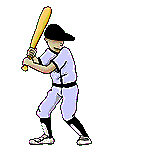

VIII. A Brief History of Sports Cards
The first sport cards made were of baseball players in 1869.
Baseball cards ruled supreme for about 100 years or so.
Cards were inserted in tobacco, candy, or chewing gum as an added
incentive to buy those items. This was a typical marketing ploy
during those days. When I was a kid I remember getting a
free drinking glass inside a large box of breakfast oats cereal.
Or a free 45 rpm record of the Archies playing their tune Sugar Sugar
on the back of another cereal box. Other incentives to buy certain
products were green stamps and blue chip stamps that you got when you
bought gasoline from a certain station or merchandise from a certain
store. These kinds of incentives worked very well, I remember, with my
family. Once your coupon books were full of stamps you could redeem
them for merchandise at the appropriate place. Then, later, all of
this was fazed out.

IX. Buying Sports Cards For Your Hobby
Your local Wal-mart store has packs of sport cards that it sells as
well as does other major department stores. Sometimes an
overnight convenience store or gasoline station will sell packs. If
you go to a large shopping mall you will find that some toy stores will
sell packs of sports cards there as well. Sometimes a "mom and pop
store" will carry cards. My son and I always liked to buy packs at
different stores in the hopes of getting that one pack that would
contain that one card that was worth a considerable amount of money
that we couldn't afford to buy. We never got one but spent a lot of
time shopping around.
If you live in a small town then you might not have a local sports
store close to you. However, when you get to the city you will
find one or more there. Shop around and compare prices. Different
sports stores are as different as night and day. Inventories differ
and the prices of cards differ. The dealer will have many items for
sale there. One dealer in our area used to have a special box of cards where you
could buy two for the price of one. My son and I always looked in that
box first...
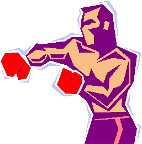
If you live in a fairly large town then chances are there is going to
be a sports card show there some day. Usually, a number of dealers get
together and decide to put one of these on. Sometimes there is one a
month on a regular basis. Check your newspaper listings frequently or
ask your local sports card shop owner (as he or she will usually have
a dealer's table there) and will have the answer for you.
A flea market can be similar to a card show except the merchants at a
flea market usually sell general merchandise rather than sports cards.
However, some card dealers can set up a booth selling cards at their
local flea market.
 45. Your Local Garage Sale-
45. Your Local Garage Sale-
If you live in a fairly large community then know for a fact that there
are individuals who live there who have card collections. Sometimes an
individual may want to sell some of his or her cards. When they do they
may decide to sell them at a garage sale. Usually, that individual will
advertise cards for sale (along with what other general merchandise
that they want to get rid of) in the local newspaper. My son and I went
to one after another of these and picked up a lot of great cards that
way. As a matter of fact I purchased my signed Dave Dravecky card at
a garage sale.
A classified Ad is one way to advertise for a sports card that you want to
purchase. Dealers usually browse these ads in the hopes of having a
card that you want- for a price that is.
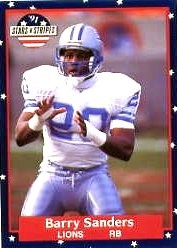
X. Selling Your Sports Cards
Are you sure that you want to get rid of that card? Don't be too
hasty. Once you turn it loose you may never have the opportunity of
getting it back again. If you are collecting only a team set and sell
off your extras, what happens when you change your mind and decide to
build a base set that is worth more money? Then you will need back those
cards that used to be only your extras. Then you will have to buy
again all of those cards (at full value) that you originally sold off
(at less than half value). Changing your mind can cost you money.
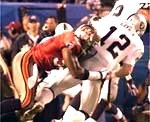 48. Selling To The Sports Card Shop-
48. Selling To The Sports Card Shop-
Sports card shops specialize in selling sports cards as well as other
things. That's what they are in business to do. How do they do it?
They buy low and sell high. That way each store owner has some money coming
in that helps pay the rent and put some beans on the table. What does
that mean to you? That means that you are probably going to get less
than half Beckett value in cash for each card that you sell.
You can sell your cards to a dealer, a card collector, or to a
distant sports card shop online who may want to buy them. Some
sellers think that
they can do better trading for what they want rather than selling
a card or two off at a time. Trading across rather than selling
down
is worth considering. There are different trading boards online that
will help you trade your cards.

Most dealers at a card show don't have time to look through what you
have to sell to them on the spot. Most find it advantageous to get
your name and phone number, make an appointment with you, and then
look at your collection at a more favorable time. If you need
emergency money you can take your cards to the card show for quick
cash but don't expect to get over 10% value for them.
Generally, you should be able to sell your cards at a flea market,
a garage sale, or with a classified ad in your local newspaper.
You may want to send one of your cards to a grading company to get it
graded or send it to an individual who has purchased it. Either way it
is important that you send it the right way so that it does not get
damaged and lose it's value.
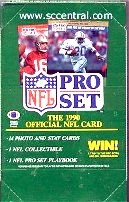 Packing the Sports Card Fun Way:
Packing the Sports Card Fun Way:
Here is some good advice from one of the nice folks over at
Sports Card Fun Way. I now quote from what is on part of their
website:
" A. Put the sports card into a soft sleeve.
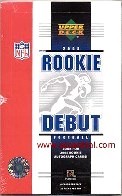
Here is some good advice from one of the nice folks over at BGS.
BGS is one of the card grading companies.
I now quote from what is on part of their website:
" So you've carefully selected the cards you plan to submit. You've
scrutinized them for any weaknesses, and you feel pretty good about
sending them in for grading. The submission form is filled out
correctly, and everything is all set, right? Wrong!
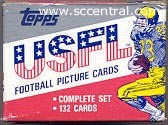
XI. Miscellaneous
If you are collecting football cards then which football leagues should
you collect? Nearly everyone says NFL and AFL, of course. Most
Canadians would say the CFL. However, the US Football League had some
football cards. This league had
three consecutive Heisman Trophy winners and some MVPs and all-stars.
There are some rookie cards of players who later played for the NFL
and the CFL. This league existed during
1984 and 1985 or so. Maybe a card of a player that you are
collecting is in the US Football League set.
Every so often a bakery, restaurant, cereal company, etc. will put out
a set of baseball cards. In the old days cards were inserted into
packs of gum. Today they are inserted into bread items, into cereal
boxes, and cup cakes, etc. The card industry calls them regional
because the cards only circulate within the reach of that company's
product distribution area. Maybe your favorite player is
featured on one of those cards. If so, you have to have it for your
collection. Baseball still rules and most cards put out by regional
companies are of that sport. Some regional companies include
Johnston Cookies, Remar Bread, Smith's Clothing,
Mother's Cookies, Post Cereal, and Sugardale Meats, etc.
Hostess printed a few cards in 1975.
An error card can be worth some money to a collector who collects
these kinds of cards because it is a novelty item as well as a
rare card. If you find a card with a blank back, a blank front,
a wrong back, or a mis-cut then hang onto it. I found a card onetime
that had one player's name on it but it had another player's photo
on it. Unfortunately, I don't remember what I did with it.
A trimmed card is a card that has been cut or shaved along the
edges. This can be done with a pair of scissors or with a
straight edge cutter. Some deceivers use a pen knife and ruler.
The idea is to make an off centered card look more centered so one can
sell it for a higher price. After all, few hobby collectors measure
each one of their sports cards with a ruler. Trimming can also remove
some roundness off of a bad corner or two. If you send in a trimmed
card for grading the grader will judge the card to be worthless.
The grader does not want to tell you that, nor does he or she want to
hurt your feelings. Rather, the grader will just return the card to
you ungraded. It is kind of an unwritten rule of the game so to speak.
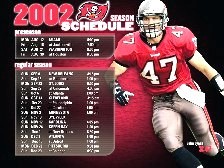
There are at
least three ways for you to know how many cards you have to
collect so you can finish collecting your entire base set.
Be careful if you buy an expensive unseen card from a person. Make sure that the
card that you are buying has been graded. If it hasn't then you might
be buying a pig in the poke. That means that you might be buying a
card that is near worthless. Why pay good money for someone else's
junk? The card that you are buying unseen might be off centered or
damaged in some other way. So be careful not to get taken.
A signature card is a card that has a player's signature on it.
Before the turn of the century some signature cards were printed but
were not as prevalent as they are today. Today, a player's signature
is printed on his card. Many signature cards are also rookie cards,
but then again, many are not. Check your Beckett is you have any doubts.

XII. Conclusion

 Dave Dravecky's "Be Real" article. Dave was a baseball
pitcher with the San Francisco Giants until he went through a trial of his faith...
Dave Dravecky's "Be Real" article. Dave was a baseball
pitcher with the San Francisco Giants until he went through a trial of his faith...




Click Here- An Important Link For You To Click On

Click here to go to the index of indexes page

